Caspian Sea
| Caspian Sea | |
|---|---|
| Max. length | 1,030 km (640 mi) |
| Max. width | 435 km (270 mi) |
| Surface area | 371,000 km2 (143,200 sq mi) |
| Average depth | 211 m (690 ft) |
| Max. depth | 1,025 m (3,360 ft) |
| Water volume | 78,200 km3 (18,800 cu mi) |
| Residence time | 250 years |
| Shore length1 | 7,000 km (4,300 mi) |
| Surface elevation | −28 m (−92 ft) |
| Islands | 26+ |
| Settlements | Baku (Azerbaijan), Bandar-e Anzali (Iran), Aqtau (Kazakhstan), Makhachkala (Russia), Türkmenbaşy (Turkmenistan) (see article) |
| References | [1] |
| 1 Shore length is not a well-defined measure. | |
The Caspian Sea is the world's largest inland body of water, often described as the world's largest lake and sometimes referred to as a full-fledged sea.[2][3][4] An endorheic basin, it lies between Europe and Asia: east of the Caucasus, west of the broad steppe of Central Asia, south of the fertile plains of Southern Russia in Eastern Europe, and north of the mountainous Iranian Plateau. It covers a surface area of 371,000 km2 (143,000 sq mi) (excluding the highly saline lagoon of Garabogazköl to its east), an area approximately equal to that of Japan, with a volume of 78,200 km3 (19,000 cu mi).[5] It has a salinity of approximately 1.2% (12 g/L), about a third of the salinity of average seawater. It is bounded by Kazakhstan to the northeast, Russia to the northwest, Azerbaijan to the southwest, Iran to the south, and Turkmenistan to the southeast.
The sea stretches 1,200 km (750 mi) from north to south, with an average width of 320 km (200 mi). Its gross coverage is 386,400 km2 (149,200 sq mi) and the surface is about 27 m (89 ft) below
Written accounts from the ancient inhabitants of its coast perceived the Caspian Sea as an ocean, probably because of its salinity and large size. With a surface area of 371,000 square kilometres (143,000 sq mi), the Caspian Sea is nearly five times as big as
Etymology
The sea's name stems from
Some Turkic ethnic groups refer to it with the Caspi(an) descriptor; in
In Iran, the lake is referred to as the Mazandaran Sea (
Old Russian sources use the Khvalyn or Khvalis Sea (Хвалынское море / Хвалисское море) after the name of
Among Greeks and Persians in classical antiquity it was the Hyrcanian ocean.[16]
Renaissance European maps labelled it as the Abbacuch Sea (Oronce Fine's 1531 world map), Mar de Bachu (Ortellius' 1570 map), or Mar de Sala (the Mercator 1569 world map).
It was also sometimes called the Kumyk Sea[17] and Tarki Sea[18] (derived from the name of the Kumyks and their historical capital Tarki).
Basin countries
Border countries
North
 Kazakhstan
Kazakhstan Russia
Russia
- States: Dagestan, Kalmykia, Astrakhan Oblast
- Districts: North Caucasian Federal District, Southern Russia
South
Non-border countries
 Armenia (all)
Armenia (all) Georgia (its east part)
Georgia (its east part) Turkey (extreme north-eastern parts)
Turkey (extreme north-eastern parts) Uzbekistan (extreme western parts)
Uzbekistan (extreme western parts)
Physical characteristics
Formation
The Caspian Sea is at its South Caspian Basin, like the
Geography

The Caspian Sea is the largest inland body of water in the world by area and accounts for 40–44% of the total lake waters of the world, The Garabogazköl Bay is the saline eastern inlet of the Caspian, which is part of Turkmenistan and at times has been a lake in its own right due to the isthmus that cuts it off from the Caspian.
Differences between the three regions are dramatic. The Northern Caspian only includes the Caspian shelf,[28] and is very shallow; it accounts for less than 1% of the total water volume with an average depth of only 5–6 m (16–20 ft). The sea noticeably drops off towards the Middle Caspian, where the average depth is 190 m (620 ft).[27] The Southern Caspian is the deepest, with oceanic depths of over 1,000 m (3,300 ft), greatly exceeding the depth of other regional seas, such as the Persian Gulf. The Middle and Southern Caspian account for 33% and 66% of the total water volume, respectively.[25] The northern portion of the Caspian Sea typically freezes in the winter, and in the coldest winters ice forms in the south as well.[29]
Over 130 rivers provide inflow to the Caspian, the
The Caspian Sea has numerous islands near the coasts, but none in the deeper parts of the sea.
Climate
The climate of the Caspian Sea is variable, with the
Hydrology

The Caspian has characteristics common to both seas and lakes. It is often listed as the world's largest lake, although it is not
It contains about 3.5 times as much water, by volume, as all five of North America's
The sea level of the Caspian has fallen and risen, often rapidly, many times over the centuries. Some Russian historians[
Over the centuries, Caspian Sea levels have changed in synchrony with the estimated discharge of the Volga, which in turn depends on rainfall levels in its vast catchment basin. Precipitation is related to variations in the amount of North Atlantic depressions that reach the interior, and they in turn are affected by cycles of the North Atlantic oscillation. Thus levels in the Caspian Sea relate to atmospheric conditions in the North Atlantic, thousands of kilometres to the northwest.[30]
The last short-term sea-level cycle started with a sea-level fall of 3 m (10 ft) from 1929 to 1977, followed by a rise of 3 m (10 ft) from 1977 until 1995. Since then smaller oscillations have taken place.[31]
A study by the Azerbaijan Academy of Sciences estimated that the level of the sea was dropping by more than six centimetres per year due to increased evaporation due to rising temperatures caused by climate change.[32]
Environmental degradation
The
The magnitude of fossil fuel extraction and transport activity in the Caspian also poses a risk to the environment. The island of Vulf off Baku, for example, has suffered ecological damage as a result of the petrochemical industry; this has significantly decreased the number of species of marine birds in the area. Existing and planned oil and gas pipelines under the sea further increase the potential threat to the environment.[33]
The high concentration of mud volcanoes under the Caspian Sea were thought to be the cause of a fire that broke out 75 kilometers from Baku on July 5, 2021. The State oil company of Azerbaijan SOCAR said preliminary information indicated it was a mud volcano which spewed both mud and flammable gas.[34]
It is calculated that during the 21st century, the water level of the Caspian Sea will decrease by 9–18 m (30–60 ft) due to the acceleration of evaporation due to
On October 23, 2021, Kazakhstan President Kassym-Jomart Tokayev signed the Protocol for the Protection of the Caspian Sea against Pollution from Land-based Sources in order to ensure better protection for the biodiversity of the Caspian Sea.[36]
Flora and fauna
Flora
The rising level of the Caspian Sea between 1995 and 1996 reduced the number of habitats for rare species of aquatic vegetation. This has been attributed to a general lack of seeding material in newly formed coastal lagoons and water bodies.[37][38]
Many rare and endemic plant species of Russia are associated with the
These affect aquatic plants of the Volga Delta, such as
Since 2019
Fauna

The
Archeological studies of
The sea's
Six sturgeon species, the Russian, bastard, Persian, sterlet, starry and beluga, are native to the Caspian Sea.[41] The last of these is arguably the largest freshwater fish in the world. The sturgeon yield roe (eggs) that are processed into caviar. Overfishing has depleted a number of the historic fisheries.[46] In recent years, overfishing has threatened the sturgeon population to the point that environmentalists advocate banning sturgeon fishing completely until the population recovers. The high price of sturgeon caviar – more than 1,500 Azerbaijani manats[32] (US$880 as of April 2019[update]) per kilo – allows fishermen to afford bribes to ensure the authorities look the other way, making regulations in many locations ineffective.[47] Caviar harvesting further endangers the fish stocks, since it targets reproductive females.

- The Asiatic cheetah used to occur in the Trans-Caucasus and Central Asia, but is today restricted to Iran.[48][49]
- The Asiatic lion used to occur in the Trans-Caucasus, Iran, and possibly the southern part of Turkestan.[48][49]
- The Caspian tiger used to occur in northern Iran, the Caucasus and Central Asia.[48][49]
- The endangered
History
Geology
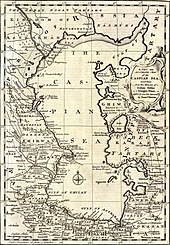

Early settlement nearby
The earliest hominid remains found around the Caspian Sea are from
Hafiz-i Abru, a fourteenth century Timurid Empire geographer, has recorded that the destruction of Oxus river dam and irrigation works which diverting the river flow towards Caspian sea, has caused Aral sea to nearly disappeared.[55][56]
Chinese maximal limit
Later, in the Tang dynasty (618–907), the sea was the western limit of the Chinese Empire.[57][58][dubious ]
Fossil fuel
The area is rich in
Today, oil and gas platforms abound along the edges of the sea.[61]
During the rule of
Cities

Ancient
- Hyrcania, ancient state in the north of Iran
- Mazandaran Provinceof Iran
- Gilan Provinceof Iran
- Astara, Gilan Province of Iran
- Golestan Provinceof Iran
- Tamisheh, Golestan Province of Iran
- Atil, Khazaria
- Khazaran
- Baku, Azerbaijan
- Derbent, Dagestan, Russia
- Xacitarxan, modern-day Astrakhan
Modern
- Iran:
- Azerbaijan:
- Kazakhstan:
- Russia:
- Turkmenistan:
- Türkmenbaşy (formerly Krasnovodsk)
- Hazar (formerly Çeleken)
- Esenguly
- Garabogaz (formerly Bekdaş)
Economy
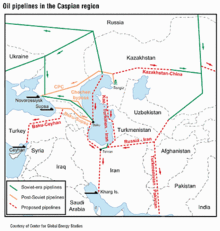
Countries in the Caspian region, particularly
All of the countries are rich in solar energy and harnessing potential, with the highest rainfall much less than the mountains of central Europe in the mountains of the west, which are also rich in hydroelectricity sources.
Iran has high fossil fuel energy potential. It has reserves of 137.5 billion barrels of crude oil, the fourth largest in the world, producing around four million barrels a day. Iran has an estimated 988.4 trillion cubic feet of natural gas, around 16 percent of world reserves, thus key to current paradigms in global energy security.[63]
Caspian
The Caspian countries develop robust cooperation in the tech and digital field as part of the Caspian Digital Hub. The project helps expand data transmission capabilities in Kazakhstan as well as data transit capabilities between Asia and Europe. The project generated interest from investors from all over the world, including the UK.[68]
Oil and gas
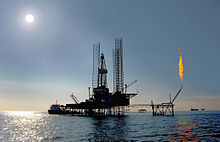
The Caspian Sea region presently is a significant, but not major, supplier of
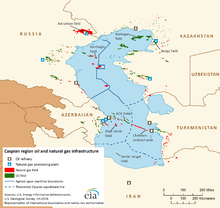
The world's first offshore wells and machine-drilled wells were made in Bibi-Heybat Bay, near
By the beginning of the 20th century, Baku was the center of the international oil industry. In 1920, when the Bolsheviks captured Azerbaijan, all private property, including oil wells and factories, was confiscated. Rapidly the republic's oil industry came under the control of the Soviet Union. By 1941, Azerbaijan was producing a record 23.5 million tons of oil per year – its Baku region output was nearly 72 percent of the Soviet Union's oil.[59]
In 1994, the "
The Vladimir Filanovsky oil field in the Russian section of the body of water was discovered in 2005. It is reportedly the largest found in 25 years. It was announced in October 2016 that Lukoil would start production from it.[70]
Transport
The Caspian Sea Shipping Company of Azerbaijan, which acts as a liaison in the Transport Corridor Europe-Caucasus-Asia (TRACECA), simultaneously with the transportation of cargo and passengers in the Trans-Caspian direction, also performs work to fully ensure the processes of oil and gas production at sea. In the 19th century, the sharp increase in oil production in Baku gave a huge impetus to the development of shipping in the Caspian Sea, and as a result, there was a need to create fundamentally new floating facilities for the transportation of oil and oil products.[72]
Political issues
Many of the islands along the Azerbaijani coast retain great geopolitical and economic importance for demarcation-line oil fields relying on their national status.
bay, hold oil reserves.The collapse of the Soviet Union allowed the market opening of the region. This led to intense investment and development by international oil companies. In 1998, Dick Cheney commented that "I can't think of a time when we've had a region emerge as suddenly to become as strategically significant as the Caspian."[73]
A key problem to further local development is arriving at precise, agreed demarcation lines among the five
Much controversy currently exists over the proposed Trans-Caspian oil and gas pipelines. These projects would allow Western markets easier access to Kazakh oil and, potentially, Uzbek and Turkmen gas as well. Russia officially opposes the project on environmental grounds.[74] However, analysts note that the pipelines would bypass Russia completely, thereby denying the country valuable transit fees, as well as destroying its current monopoly on westward-bound hydrocarbon exports from the region.[74] Recently, both Kazakhstan and Turkmenistan have expressed their support for the Trans-Caspian Pipeline.[75]
Leaked U.S. diplomatic cables revealed that BP covered up a gas leak and blowout incident in September 2008 at an operating gas field in the Azeri-Chirag-Guneshi area of the Azerbaijan Caspian Sea.[76][77]
Territorial status
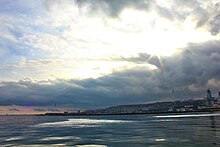
Coastline
Five states are located along about 4,800 km (3,000 mi) of Caspian coastline. The length of the coastline of these countries:[78]
- Kazakhstan - 1,422 km (884 mi)
- Turkmenistan - 1,035 km (643 mi)
- Azerbaijan - 813 km (505 mi)
- Russia - 747 km (464 mi)
- Iran - 728 km (452 mi)
Negotiations
In 2000, negotiations as to the
Resolving and improving some
All five Caspian littoral states maintain naval forces on the sea.[80]
According to a treaty signed between Iran and the Soviet Union, the sea is technically a lake and was divided into two sectors (Iranian and Soviet), but the resources (then mainly fish) were commonly shared. The line between the two sectors was considered an international border in a common lake, like Lake Albert. The Soviet sector was sub-divided into the four littoral republics' administrative sectors.
Russia, Kazakhstan, and Azerbaijan have bilateral agreements with each other based on
The Caspian littoral states' meeting in 2007 signed an accord that only allows littoral-state flag-bearing ships to enter the sea.[81][failed verification]
Negotiations among the five states ebbed and flowed, from about 1990 to 2018. Progress was notable in the fourth Caspian Summit held in Astrakhan in 2014.[82]
Caspian Summit
The Caspian Summit is a head of state-level meeting of the five littoral states.[83] The fifth Caspian Summit took place on August 12, 2018, in the Kazakh port city of Aktau.[83] The five leaders signed the 'Convention on the Legal Status of the Caspian Sea'.[84]
Representatives of the Caspian littoral states held a meeting in the capital of Kazakhstan on September 28, 2018, as a follow-up to the Aktau Summit. The conference was hosted by the Kazakh Ministry of Investment and Development. The participants in the meeting agreed to host an investment forum for the Caspian region every two years.[85]
Convention on the legal status of the Caspian Sea
The five littoral states build consensus on legally binding governance of the Caspian Sea through Special Working Groups of a Convention on the Legal Status of the Caspian Sea.[86] In advance of a Caspian Summit, the 51st Special Working Group took place in Astana in May 2018 and found consensus on multiple agreements: Agreements on cooperation in the field of transport; trade and economic cooperation; prevention of incidents on the sea; combating terrorism; fighting against organized crime; and border security cooperation.[87]
The convention grants jurisdiction over 24 km (15 mi) of territorial waters to each neighboring country, plus an additional 16 km (10 mi) of exclusive fishing rights on the surface, while the rest is international waters. The seabed, on the other hand, remains undefined, subject to bilateral agreements between countries. Thus, the Caspian Sea is legally neither fully a sea nor a lake.[88]
While the convention addresses caviar production, oil and gas extraction, and military uses, it does not touch on environmental issues.[32]
Crossborder inflow
| River | Countries |
|---|---|
Atrek River
|
Iran, Turkmenistan |
Kura River
|
Armenia, Azerbaijan, Georgia, Iran, Turkey |
Ural River
|
Kazakhstan, Russia |
Samur River
|
Azerbaijan, Russia |
Sulak River
|
Georgia, Russia |
Terek River
|
Georgia, Russia |
Transportation
Although the Caspian Sea is
Another Caspian tributary, the
Scheduled ferry services (including train ferries) across the sea chiefly are between:
- Türkmenbaşy in Turkmenistan, (formerly Krasnovodsk) and Baku.
- Aktau, Kazakhstan and Baku.
- Cities in Iran and Russia (chiefly for cargo.)
Canals
As an
The two modern canal systems that connect the Volga Basin, and hence the Caspian Sea, with the ocean are the Volga–Baltic Waterway and the Volga–Don Canal.
The proposed
In June 2007, in order to boost his oil-rich country's access to markets, Kazakhstan's President Nursultan Nazarbayev proposed a 700 km (435 mi) link between the Caspian Sea and the Black Sea. It is hoped that the "Eurasia Canal" (Manych Ship Canal) would transform landlocked Kazakhstan and other Central Asian countries into maritime states, enabling them to significantly increase trade volume. Although the canal would traverse Russian territory, it would benefit Kazakhstan through its Caspian Sea ports. The most likely route for the canal, the officials at the Committee on Water Resources at Kazakhstan's Agriculture Ministry say, would follow the Kuma–Manych Depression, where currently a chain of rivers and lakes is already connected by an irrigation canal (the Kuma–Manych Canal). Upgrading the Volga–Don Canal would be another option.[90]
See also
- Caspians
- Caspian languages
- Caspian Sea Monster
- Baku oil fields
- Epoch of Extreme Inundations
- Eurasia Canal
- Framework Convention for the Protection of the Marine Environment of the Caspian Sea
- Iranrud
- Shah Deniz gas field
- South Caucasus Pipeline
- Southern Gas Corridor
- Tengiz Field
- Trans-Caspian Gas Pipeline
- Trans-Caspian Oil Transport System
- Volga–Don Canal
- Wildlife of Azerbaijan
- Wildlife of Iran
- Wildlife of Kazakhstan
- Wildlife of Turkmenistan
- Wildlife of Russia
References
- ^ a b van der Leeden, Troise, and Todd, eds., The Water Encyclopedia. Second Edition. Chelsea F.C., MI: Lewis Publishers, 1990, p. 196.
- ^ "Convention on the Legal Status of the Caspian Sea". President Of Russia. 12 August 2018. Archived from the original on 12 March 2022. Retrieved 22 January 2022.
- from the original on 19 August 2018. Retrieved 22 January 2022.
- S2CID 154951201.
- ISBN 978-0-19-562816-6. Archivedfrom the original on 16 October 2022. Retrieved 17 January 2022.
- ^ "Great Lakes – Physical Facts". United States Environmental Protection Agency. Archived from the original on 29 October 2010. Retrieved 1 January 2023.
- ^ S2CID 4363852.
- ^ a b Wesselingh, Frank; Lattuada, Matteo (23 December 2020). "The Caspian Sea is set to fall by 9 metres or more this century – an ecocide is imminent". The Conversation. Retrieved 29 June 2023.
- ^ S2CID 229357523.
- ^ Caspian Sea Archived 2008-01-07 at the Wayback Machine in Encyclopædia Britannica.
- ^ "Strabo. Geography. 11.3.1". Perseus.tufts.edu. Archived from the original on 11 May 2011. Retrieved 14 April 2011.
- ^ "موضوع : بررسی تطبیقی رژیم حقوقی بزگترین دریاچه های جهان و دریای خزر /کسپین/نام های دریاچه خزر | پژوهشهای ایرانی.دریای پارس" [Topic: Comparative study of the legal regime of the world's largest lakes and the Caspian Sea / Caspian / Caspian Lake names | Iranian researches. Pars sea]. parssea.org. Archived from the original on 8 October 2018. Retrieved 15 January 2022.
- ISBN 978-1-74104-293-1.
- ISBN 978-3-642-11524-0. Archivedfrom the original on 18 October 2022. Retrieved 20 July 2022.
- ^ Max Vasmer, Etimologicheskii slovar' russkogo yazyka, Vol. IV (Moscow: Progress, 1973), p. 229.
- ^ Hyrcania Archived 2011-06-04 at the Wayback Machine. www.livius.org. Retrieved 2012-05-20.
- ^ Абдулгаффар Кырыми. Умдет ал-ахбар. Книга 2: Перевод. Серия «Язма Мирас. Письменное Наследие. (tr. "Abdulgaffar Crimea. Umdet al-ahbar. Book 2: Translation. Series "Written Heritage. Written Heritage.") Textual Heritage». Вып. 5 / Пер. с османского Ю. Н. Каримовой, И. М. Миргалеева; общая и научная редакция, предисловие и комментарии И. М. Миргалеева. — Казань: Институт истории им. Ш. Марджани АН РТ, 2018. — 200 с
- ^ Гусейнов Г.-Р., "Султан-Мут и западные пределы кумыкского государства", материалы научной конференции, (tr. " "Sultan-Mut and the western limits of the Kumyk state", materials of the scientific conference") journal Средневековые тюрко-татарские государства, 2009
- S2CID 129203844.
- ^ Caspian Sea: Largest Inland Body of Water - Live Science
- S2CID 134219493. Retrieved 8 December 2022.
- ^ "Sea Facts". Casp Info. Archived from the original on 26 February 2017. Retrieved 25 February 2017.
- ^ a b "Caspian Sea – Background". Caspian Environment Programme. 2009. Archived from the original on 3 July 2013. Retrieved 11 September 2012.
- ^ "Caspian Sea". Iran Gazette. Archived from the original on 22 January 2009. Retrieved 17 May 2010.
- ^ ISBN 978-0-312-22351-9. Archivedfrom the original on 28 May 2013. Retrieved 20 May 2012.
- S2CID 129017738.
- ^ ISBN 978-1-4020-1869-5. Archivedfrom the original on 28 May 2013. Retrieved 20 May 2012.
- ISBN 978-3-540-28281-5. Archivedfrom the original on 28 May 2013. Retrieved 20 May 2012.
- ^ "News Azerbaijan". ann.az. Archived from the original on 12 May 2013. Retrieved 9 October 2015.
- ^ "Temperature and precipitation in the Caspian Sea Region | GRID-Arendal". www.grida.no. Archived from the original on 26 May 2021. Retrieved 5 July 2021.
- ^ "Welcome to the Caspian Sea Level Project Site". Caspage.citg.tudelft.nl. Archived from the original on 24 July 2011. Retrieved 17 May 2010.
- ^ a b c d e "Caviar pool drains dry as Caspian Sea slides towards catastrophe". The Nation. Bangkok. Agence France-Presse. 18 April 2019. Archived from the original on 17 April 2019. Retrieved 18 April 2019.
- ^ "Caspian Environment Programme". caspianenvironment.org. Archived from the original on 13 April 2010. Retrieved 30 October 2012.
- ^ "Azerbaijan Investigates Large Fire In Caspian Sea". Radio Free Europe/Radio Liberty. 5 July 2021. Archived from the original on 5 July 2021. Retrieved 5 July 2021.
- ^ Times, The Moscow (25 December 2020). "Scientists Sound the Alarm Over Fast-Shrinking Caspian Sea". The Moscow Times. Retrieved 29 June 2023.
- ^ November 2021, Assel Satubaldina in Central Asia on 3 (3 November 2021). "President Tokayev Pledges to Better Protect Caspian Sea Biodiversity by Signing Caspian Sea Protection Protocol". The Astana Times. Archived from the original on 3 November 2021. Retrieved 3 November 2021.
{{cite web}}: CS1 maint: numeric names: authors list (link) - ^ "Caspian Sea Biodiversity Project - Biodiversity Report". www.zin.ru. Archived from the original on 16 January 2021. Retrieved 5 July 2021.
- ISBN 978-953-307-417-7. Archivedfrom the original on 18 October 2022. Retrieved 24 July 2021.
- ^ "Western Asia: Along the coast of the Caspian Sea in Russia, Kazakhstan, Turkmenistan, and Iran | Ecoregions | WWF". World Wildlife Fund. Archived from the original on 1 May 2013. Retrieved 5 July 2021.
- ^ "Hyrcanian Forests". UNESCO World Heritage Centre. 1 July 2022. Archived from the original on 12 July 2019. Retrieved 21 July 2022.
- ^ a b c d e f g h i Naseka, A.M. and Bogutskaya, N.G. (2009). "Fishes of the Caspian Sea: zoogeography and updated check-list". Zoosystematica Rossica 18(2): 295–317.
- ^ a b c d Gallagher, Ronnie (2011). "The Ice Age Rise and Fall of the Ponto Caspian: Ancient Mariners and the Asiatic Mediterranean". Stratigraphy and Sedimentology of Oil-gas Basins (pp. 48-68) on Academia.edu. Retrieved 15 February 2024.
- ^ Фараджева, Малахат (2015). "Культурно-исторический контекст археологического комплекса Гобустан". Российская Археология (4): 50–63. Archived from the original on 21 February 2019. Retrieved 20 February 2019 – via Acedemia.edu.
- ^ a b "Gobustan Petroglyphs – Subject Matter". The Smithsonian Institution. Archived from the original on 28 April 2015. Retrieved 19 January 2015.
- ^ "Gobustan Petroglyphs – Methods & Chronology". The Smithsonian Institution. Archived from the original on 28 April 2015. Retrieved 19 January 2015.
- ^ C. Michael Hogan. "Overfishing". Encyclopedia of Earth. eds. Sidney Draggan and Cutler Cleveland. National Council for Science and the Environment, Washington DC
- ^ "Fishing Prospects". Iran Daily. 14 January 2007. Archived from the original on 5 September 2008. Retrieved 20 May 2012.
- ^ a b c d Heptner, V.G., Sludskij, A.A. (1992) [1972]. Mlekopitajuščie Sovetskogo Soiuza. Moskva: Vysšaia Škola [Mammals of the Soviet Union. Volume II, Part 2. Carnivora (Hyaenas and Cats)]. Washington DC: Smithsonian Institution and the National Science Foundation. pp. 1–732. Archived from the original on 20 October 2017. Retrieved 10 April 2017.
{{cite book}}: CS1 maint: multiple names: authors list (link) - ^ a b c d Humphreys, P., Kahrom, E. (1999). Lion and Gazelle: The Mammals and Birds of Iran Archived 2016-04-30 at the Wayback Machine. Images Publishing, Avon.
- ISSN 0024-3590.
- ^ "Major Monuments" Archived May 14, 2011, at the Wayback Machine. Iranair.com. Retrieved 2012-05-20.
- ^ "Safeguarding Caspian Interests". Archived from the original on 3 June 2009. Retrieved 7 February 2016.. iran-daily.com (2006-11-26)
- ^ "Strabo, Geography, § 2.5.14". Archived from the original on 13 April 2019. Retrieved 30 March 2019.
- ^ "Cosmas Indicopleustes, Christian Topography, §132". Archived from the original on 22 April 2017. Retrieved 30 March 2019.
- ISBN 9780199768660. Retrieved 2 December 2023.
... Sea but identified an old bed that led to the Caspian. Writing in the fifteenth century, following the destruction of dams and irrigation works on the Oxus that diverted the river's flow toward the Caspian Sea, the Timurid geographer ...
- S2CID 134377831.
- ISBN 9789042008151. Archivedfrom the original on 4 February 2021. Retrieved 3 October 2020.
- ISBN 9780357365472. Archivedfrom the original on 4 February 2021. Retrieved 3 October 2020.
- ^ a b "The Development of the Oil and Gas Industry in Azerbaijan Archived 2007-09-29 at the Wayback Machine". SOCAR[full citation needed]
- ^ "Back to the Future: Britain, Baku Oil and the Cycle of History Archived 2007-09-29 at the Wayback Machine". SOCAR[full citation needed]
- ^ "Caspian Sea Map, Caspian Sea Location Facts History, Major Bodies of Water". World Atlas. 29 September 2015. Archived from the original on 22 December 2017. Retrieved 19 December 2017.
- ^ "Fedor I. Soimonov". Encyclopædia Britannica. Archived from the original on 29 November 2014. Retrieved 9 October 2015.
- ^ ISBN 978-0-230-22755-2. Archivedfrom the original on 20 October 2020. Retrieved 3 October 2020.
- ^ "Report for Selected Countries and Subjects". www.imf.org. Archived from the original on 18 September 2018. Retrieved 5 December 2018.
- ^ "Commission of the Russian Federation for UNESCO". www.unesco.ru. Archived from the original on 23 March 2011. Retrieved 5 December 2018.
- ^ "The World Factbook — Central Intelligence Agency". www.cia.gov. Archived from the original on 15 March 2016. Retrieved 5 December 2018.
- ^ "The Astana Times". astanatimes.com. 13 August 2019. Archived from the original on 13 August 2019. Retrieved 2 October 2019.
- ^ "British Investors Consider Plan to Create Caspian Digital Hub in Aktau". The Astana Times. 26 May 2020. Archived from the original on 7 January 2021. Retrieved 11 December 2020.
- ^ Geld, Bernard (9 April 2002). "Caspian Oil and Gas: Production and Prospects" (PDF). wvvw.iwar.org.uk. Archived from the original (PDF) on 6 December 2018. Retrieved 5 December 2018.
- ^ "LUKOIL starts up V. Filanovsky in the Caspian Sea". 31 October 2016. Archived from the original on 3 November 2016. Retrieved 2 November 2016.
- ^ "Volume of oil tanker transportation in Caspian Sea to increase". AzerNews.az. 1 May 2018. Archived from the original on 6 December 2018. Retrieved 5 December 2018.
- ^ "Caspian Sea-Black Sea Transport". Georgia Today on the Web. Archived from the original on 6 December 2018. Retrieved 5 December 2018.
- ^ "The Great Gas Game Archived 2007-06-08 at the Wayback Machine", Christian Science Monitor (2001-10-25)
- ^ a b Sergei Blagov, "Russia Tries to Scuttle Proposed Trans-Caspian Pipeline Archived 2007-06-10 at the Wayback Machine", Eurasianet (2006-03-27)
- ^ "Russia Seeking To Keep Kazakhstan Happy Archived 2008-05-12 at the Wayback Machine", Eurasianet (2007-12-10)
- ^ Tim Webb (15 December 2010). "WikiLeaks cables: BP suffered blowout on Azerbaijan gas platform". The Guardian. London. Archived from the original on 16 December 2010. Retrieved 26 March 2013.
- ^ Walt, Vivienne (18 December 2010). "WikiLeaks Reveals BP's 'Other' Offshore Drilling Disaster". Time. Archived from the original on 25 March 2013. Retrieved 26 March 2013.
- ^ "Characteristics of Caspian Sea". Archived from the original on 18 October 2020. Retrieved 20 March 2020.
- ^ Khoshbakht B. Yusifzade. "8.3 The Status of the Caspian Sea – Dividing Natural Resources Between Five Countries". Azer.com. Archived from the original on 2 February 2010. Retrieved 17 May 2010.
- ^ "The great Caspian arms race", Foreign Policy, June 2012, archived from the original on 9 October 2014, retrieved 6 March 2017
- ^ "Russia Gets Way in Caspian Meet". Archived from the original on 20 January 2008. Retrieved 28 October 2007.
{{cite web}}: CS1 maint: bot: original URL status unknown (link) - S2CID 152614480
- ^ a b "Five Leaders Attend Caspian Summit". RadioFreeEurope RadioLiberty. Archived from the original on 13 August 2018. Retrieved 13 August 2018.
- ^ "Five States Sign Convention On Caspian Legal Status". Radio Free Europe. Archived from the original on 14 May 2022. Retrieved 14 May 2022.
- ^ "Caspian Sea states to host sea-related investment forum every two years". astanatimes.com. 3 October 2018. Archived from the original on 25 April 2019. Retrieved 25 April 2019.
- ^ "Are the Littoral States Close to Signing an Agreement on the Legal Status of the Caspian Sea?". Jamestown. The Jamestown Foundation. Archived from the original on 13 July 2018. Retrieved 13 July 2018.
- ^ "The working group agreed on the provisional agenda of the Caspian summit and the draft of final document". caspianbarrel.org. 30 May 2018. Archived from the original on 13 July 2018. Retrieved 13 July 2018.
- ^ "Is the Caspian a sea or a lake?". The Economist. 16 August 2018. Archived from the original on 19 August 2018. Retrieved 20 August 2018.
- ^ "Drainage basin of the Caspian Sea" (PDF). UNECE. Archived (PDF) from the original on 31 July 2009. Retrieved 12 March 2012.
- Business Week(2007-07-09)
External links
- Kropotkin, Peter Alexeivitch; Bealby, John Thomas (1911). . In Chisholm, Hugh (ed.). Encyclopædia Britannica. Vol. 5 (11th ed.). Cambridge University Press. pp. 452–455.
- Names of the Caspian Sea
- Caspian Sea Region
- Dating Caspian sea level changes
